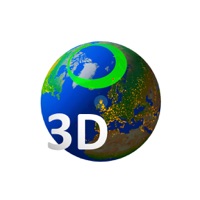
下载 Aurora Forecast 3D 为 PC
写的 - University Centre in Svalbard (UNIS)
- 类别: Weather
- 当前版本: 6.3.0
- 文件大小: 52.39 MB
- 兼容性: 需要iOS Windows 11, Windows 10/8/7/Vista

写的 - University Centre in Svalbard (UNIS)
APK 为 PC - 下载
| 下载 | 开发人员 | 评分 | 文件大小 (MB) |
|---|---|---|---|
| 下载 Apk | Fred Sigernes | 123 | 38M |
好的。首先要做的事情。如果您想在计算机上使用该应用程序,请先访问Mac商店或Windows 应用商店,然后搜索Bluestacks应用程序或 Nox 应用 。网络上的大多数教程都会推荐Bluestacks应用程序,我也可能会推荐它,因为如果您在计算机上使用 Bluestacks应用程序时遇到问题,您很可能很容易在网上找到解决方案。您可以在这里 下载Bluestacks Pc或Mac软件。
现在您已经下载了您选择的模拟器,请转至计算机上的Downloads文件夹以找到模拟器或Bluestacks应用程序。
一旦你找到它,点击它来安装应用程序或exe在你的PC或Mac电脑上。
现在单击下一步接受许可协议。
请按照屏幕上的指示正确安装应用程序。
如果你正确地完成上述操作,模拟器应用程序将被成功安装。
现在,打开已安装的模拟器应用程序并查找其搜索栏。一旦找到它,请键入 Aurora Forecast 3D 在搜索栏并按搜索。点击 Aurora Forecast 3D应用程序图标。一个 窗口 Aurora Forecast 3D 在Play商店或应用程序商店将打开并且它将在您的模拟器应用程序中显示商店。现在,按下安装按钮并像在iPhone或Android设备上一样,您的应用程序将开始下载。现在我们都完成了。
你会看到一个名为“所有应用程序”的图标。
点击它,它会带你到一个包含所有已安装应用程序的页面。
你应该看到 图标。点击它并开始使用该应用程序。
嗨。 Mac用户!
使用步骤 Aurora Forecast 3D 对于Mac而言,与上述Windows操作系统完全相同。 您只需安装 Nox 应用 模拟器 或 Bluestack在你的Macintosh上。 您可以在 此处 。
Aurora Forecast 3D 在iTunes上“
| 下载 | 开发人员 | 评分 | 分数 | 当前版本 | 成人排名 |
|---|---|---|---|---|---|
| 免费 在iTunes上“ | University Centre in Svalbard (UNIS) | 6.3.0 | 4+ |
The Aurora Forecast 3D is a tool to track down where the aurora is located in the sky from any location on planet. It renders Earth in 3D with rotation and scaling at your fingertips. You can select locations and make your own ground - station list. The Sun illuminates the globe as it updates in near real-time (1 second epochs). The short term forecasts are up to +6 hours, while the long term forecasts are up to 3 days ahead in time. They are updated when the app is active and connected to internet. An Aurora Compass is included that shows where the auroral oval, the Moon and the Sun are located as you look up at the sky from your location. The phase and age of the Moon is also visualized in the compass. By zooming out in the 3D view port, satellites, stars and planets appear in their orbits around the Sun. FEATURES - 3D view port of Earth with zoom and rotation enabled. - Solar illumination of the Earth and the Moon. - Aurora oval size and location in real time [1,2]. - Day side location of the red colored Cusp. - Forecasts based on predicted Kp index +0, +3 and +6 hours ahead in time estimated by the Space Weather Prediction Centre (NOAA-SWPC). - Color scaled Kp speedometer. - Aurora Compass sky view display. - Editable station / location list - Go to animation. - Right Ascension (RA) and Declination (DEC) of the Moon, Sun and 8 planets: Mercury, Venus, Mars, Jupiter, Saturn, Uranus, Neptune and Pluto [3] - Age of the Moon including the phase. - Includes a 2.4 million star map [4]. - City light texture [5]. - Earth, Sun and Moon textures [6,7]. - Sky view module to track planets and stars [8]. - 3-day space weather condition forecast as news ticker. - 3-day long term Kp index summary - Two-Line Element (TLE) satellite orbit calculations [9]. - Apparent Solar Time (AST) as analog clock. - Skyview navigation. - 3D Laser Star pointer to identify star signs. - Sounding rocket trajectories. - Sun and Moon daily elevation plots with rise and set time. - New app style: Calypso - Epoch selection for magnetic pole position [11] References [1] Sigernes F., M. Dyrland, P. Brekke, S. Chernouss, D.A. Lorentzen, K. Oksavik, and C.S. Deehr, Two methods to forecast auroral displays, Journal of Space Weather and Space Climate (SWSC), Vol. 1, No. 1, A03, DOI:10.1051/swsc/2011003, 2011. [2] Starkov G. V., Mathematical model of the auroral boundaries, Geomagnetism and Aeronomy, 34 (3), 331-336, 1994. [3] P. Schlyter, How to compute planetary positions, http://stjarnhimlen.se/, Stockholm, Sweden. [4] Bridgman, T. and Wright, E., The Tycho Catalog Sky map- Version 2.0, NASA/Goddard Space Flight Center Scientific Visualization Studio, http://svs.gsfc.nasa.gov/3572, January 26, 2009. [5] The Visible Earth catalog, http://visibleearth.nasa.gov/, NASA/Goddard Space Flight Center, April-October, 2012. [6] T. Patterson, Natural Earth III - Texture Maps, http://www.shadedrelief.com, October 1, 2016. [7] Nexus - Planet Textures, http://www.solarsystemscope.com/nexus/, January 4, 2013. [8] Hoffleit, D. and Warren, Jr., W.H., The Bright Star Catalog, 5th Revised Edition (Preliminary Version), Astronomical Data Center, NSSDC/ADC, 1991. [9] Vallado, David A., Paul Crawford, Richard Hujsak, and T.S. Kelso, Revisiting Spacetrack Report #3, AIAA/AAS-2006-6753, https://celestrak.com, 2006. [10] Christensen L.L., M. Andre, B. Rino, R.Y. Shida, J. Enciso, G.M. Carillo, C. Martins, and M.R. D'Antonio, The Constellations, The International Astronomical Union (IAU), https://iau.org, 2019. [11] Tsyganenko, N. A., Secular drift of the auroral ovals: How fast do they actually move?, Geophysical Research Letters, 46, 3017-3023, 2019.